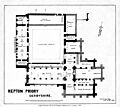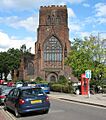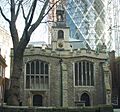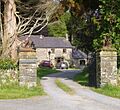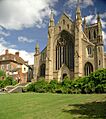List of monasteries dissolved by Henry VIII of England facts for kids
During the 1530s, King Henry VIII of England made a big change in England. He decided to close down all the monasteries, priories, convents, and friaries. This huge event is known as the Dissolution of the Monasteries. Before this, there were over 800 religious houses across England and Wales. Almost every town had at least one of these places where monks, nuns, or friars lived and worked.
Contents
What Were Monasteries?
Monasteries were special communities where religious people, like monks and nuns, lived together. They dedicated their lives to God. These places were very important in medieval times. They were not just places for prayer. They also acted like schools, hospitals, and guesthouses. Monks and nuns often helped the poor and sick. They also kept old books and knowledge safe. Many monasteries were very rich and owned a lot of land.
Why Did King Henry VIII Close Them?
King Henry VIII decided to close the monasteries for several reasons:
Money and Power
Henry VIII needed a lot of money. He had spent a lot on wars and his royal court. The monasteries were very wealthy. By closing them, he could take their lands, buildings, and treasures. This made him much richer and more powerful.
Breaking from the Pope
Henry VIII also wanted to be the head of the Church in England. He didn't want the Pope (the leader of the Catholic Church in Rome) to have power over him. The monasteries were loyal to the Pope. Closing them helped Henry VIII gain full control over religious life in England. This was part of the English Reformation, a big change in how religion was practiced.
Ideas of the Reformation
New ideas about religion were spreading across Europe. Many people, including some of Henry's advisors, believed that monasteries were no longer needed. They thought that monks and nuns were not living as strictly as they should. They also felt that the wealth of the monasteries could be better used.
How Did the Dissolution Happen?
The Dissolution happened in stages:
Smaller Monasteries First
In 1536, Henry VIII passed a law called the Dissolution of the Lesser Monasteries Act. This law closed down smaller monasteries. These were places with less than 12 monks or nuns, or those earning less than £200 a year. Many people were upset by this. There were even some rebellions, like the Pilgrimage of Grace, but they were put down.
Larger Monasteries Follow
After the smaller ones, Henry VIII went after the larger, richer monasteries. By 1539, almost all of them were closed. The King's officials visited each monastery. They made the monks and nuns leave. The buildings were often pulled down, or their valuable parts were sold. The land was then sold or given to Henry's supporters.
What Happened to the Monks and Nuns?
When the monasteries closed, the monks and nuns had to leave their homes. Some were given a small amount of money to live on. Others became priests in local churches. Many struggled to find new places to live or work.
The Impact of the Dissolution
The Dissolution of the Monasteries had a huge impact on England:
- Loss of Buildings: Many beautiful and historic buildings were destroyed. Only ruins remain of many of them today. Some, like Westminster Abbey, were saved because they became cathedrals or parish churches.
- Change in Land Ownership: A lot of land changed hands. New wealthy families gained power and influence.
- Loss of Services: The poor and sick lost the help they received from monasteries. Education and learning also suffered in some areas.
- Religious Change: It helped to establish the Church of England as separate from the Pope.
The Dissolution was a major event that changed the landscape, economy, and religious life of England forever.
Images for kids
See also
- Dissolution of the Lesser Monasteries Act
- Second Act of Dissolution
- List of monastic houses in England
- List of monastic houses in Wales
- List of monastic houses in Ireland



































































































